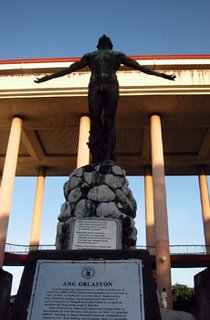 A few days ago I read an article on inq7.net about the University of the Philippines, where I spent all four years of high school and two years of college. (Well, it was more than two years, but I cut and dropped so many classes that my total credits only added up to two years.)
A few days ago I read an article on inq7.net about the University of the Philippines, where I spent all four years of high school and two years of college. (Well, it was more than two years, but I cut and dropped so many classes that my total credits only added up to two years.)Anyway, it seems that Emerlinda Roman, the current president of the university (first female one, if I'm not mistaken), is advocating a 300% increase in the per-unit college tuition fees for two campuses - the flagship Diliman campus and the health-sciences-focused Manila campus. Predictably, students staged protests against the proposed fee hikes, and at first I was sympathetic. After all, a 300% increase is huge! I was surprised at the size of the tuition hike she was proposing, but then as I continued reading the article I almost choked on the Coke I was drinking.
I was stunned to find out that U.P. only charged PHP300 per unit. Yes, just 300 pesos! That was what they were charging 17 years ago, when I was still a student! Seventeen whole years without tuition hikes. Seventeen years! Even here in the US with its low inflation, that's a very long time, but in the Philippines, where inflation is an ever-present fact of life (and dizzyingly high by first world standards), that's absolutely mind-boggling.
It was during my sophomore year that the university raised tuition fees to their current levels. Back then there was a lot of talk about how the school was failing its mission to educate the country's best minds regardless of economic standing, and the solution they came up with was the tuition hike to PHP300/unit, combined with something called STFAP (Socialized Tuition Fee Assistance Program).
STFAP classified students into nine "brackets", depending on their family income. Fees were assessed on a rising scale depending on the student's ability to pay. Students at the top bracket (9) paid full tuition, while students in the lower brackets paid ever-decreasing fees. Those at the very lowest brackets actually got money back from the university, with the caveat that they always take full loads and that they passed all their classes (no drops, incompletes, or failures). It was a fair concept, though it also triggered massive protests when it was first implemented. I personally liked the idea, because I knew that so many students who went to UP actually came from some very wealthy families that had the financial wherewithal to pay much, much more.
I don't know all the details, but from reading the article I'm under the impression that the STFAP income cutoffs were either not indexed for inflation or were indexed in such a way that it didn't keep pace. The end result is that very few people now qualify for the lowest brackets, and that the majority of students are now having to pay full tuition because they fall under bracket 9. When I was a student, my mom's income alone (she was a senior editor at the Manila Chronicle) was enough to push me into bracket 9. That was a moot point, though, because my dad was a professor at the university (still is), and all children of faculty were automatically classified as bracket 5 (free tuition; miscellaneous fees only) or lower.
And now, 17 years later, I'm appalled to find out that the STFAP classifications are so out of whack with the present economic reality. If someone's parents now make what my mom made back then, they would be REALLY hurting. They would be borderline poor, if not solidly so, and it would be very hard for them to finance a child's education at U.P. if they had to pay full tuition.
 The University of the Philippines is the crown jewel of the state university system, and its flagship campuses (Diliman and Manila) are extremely selective, with admit rates on par with (or even lower than) such schools as UC Berkeley or even Stanford. Its mission is to educate the country's best and brightest. And it cannot do that if it doesn't have the money to do so. Everyone knows that the Philippine government is (a) poor, (b) corrupt, and (c) very corrupt. The result of this combination is that it never gives enough funds to the university. In view of this, and in view of the fact that tuition hasn't changed in seventeen years, I really think that the naysayers should just quit protesting.
The University of the Philippines is the crown jewel of the state university system, and its flagship campuses (Diliman and Manila) are extremely selective, with admit rates on par with (or even lower than) such schools as UC Berkeley or even Stanford. Its mission is to educate the country's best and brightest. And it cannot do that if it doesn't have the money to do so. Everyone knows that the Philippine government is (a) poor, (b) corrupt, and (c) very corrupt. The result of this combination is that it never gives enough funds to the university. In view of this, and in view of the fact that tuition hasn't changed in seventeen years, I really think that the naysayers should just quit protesting.Yes, a 300% increase is going to be quite a shock. But then again, people have had 17 years of calm. The solution, I think, is to revamp the STFAP to make the income cutoffs more reflective of today's economy, and to index it to inflation so that it never falls behind again. At the same time, I think it's only right that the university increase its fees. Its competition in tha higher education arena (Ateneo and La Salle) surely charge astronomical fees in comparison. When U.P. raised its fees to PHP300/unit, Ateneo was already charging PHP600/unit. I don't even want to know how much it is now. A state university should of course be expected to cost far less than a comparable private school, but the difference should not be this glaring.
The school deserves better. The students deserve better. The faculty deserves better. Money is needed to pay the faculty well, to maintain facilities, and to keep up with technological change. Everyone needs to ante up. And that includes the students.
-----------
ERRATA
-----------
Bill pointed out a few errors and omissions in my previous post about our weekend:
1. The wine we had at Original Joe's only cost $21, not $32
2. He had had five beers, not four, by the time we saw Spongebob Squarepants
3. At Faultline Brewery I had gnochi with dungeness crab and he had a giant cheeseburger
4. The "red dragon roll" we had at the sushi place had shrimp, not salmon
-----------